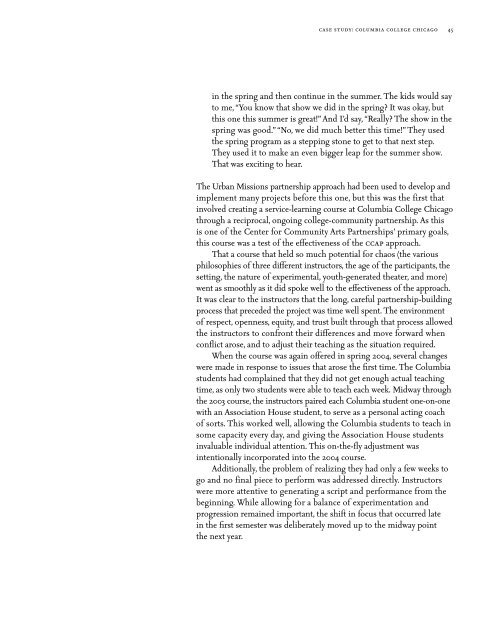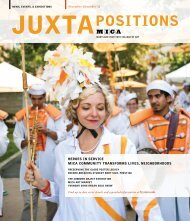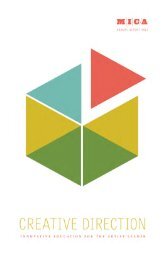art/vision/voice - Maryland Institute College of Art
art/vision/voice - Maryland Institute College of Art
art/vision/voice - Maryland Institute College of Art
Create successful ePaper yourself
Turn your PDF publications into a flip-book with our unique Google optimized e-Paper software.
case study: columbia college chicago 45<br />
in the spring and then continue in the summer. The kids would say<br />
to me, “You know that show we did in the spring? It was okay, but<br />
this one this summer is great!” And I’d say, “Really? The show in the<br />
spring was good.” “No, we did much better this time!” They used<br />
the spring program as a stepping stone to get to that next step.<br />
They used it to make an even bigger leap for the summer show.<br />
That was exciting to hear.<br />
The Urban Missions p<strong>art</strong>nership approach had been used to develop and<br />
implement many projects before this one, but this was the first that<br />
involved creating a service-learning course at Columbia <strong>College</strong> Chicago<br />
through a reciprocal, ongoing college-community p<strong>art</strong>nership. As this<br />
is one <strong>of</strong> the Center for Community <strong>Art</strong>s P<strong>art</strong>nerships’ primary goals,<br />
this course was a test <strong>of</strong> the effectiveness <strong>of</strong> the ccap approach.<br />
That a course that held so much potential for chaos (the various<br />
philosophies <strong>of</strong> three different instructors, the age <strong>of</strong> the p<strong>art</strong>icipants, the<br />
setting, the nature <strong>of</strong> experimental, youth-generated theater, and more)<br />
went as smoothly as it did spoke well to the effectiveness <strong>of</strong> the approach.<br />
It was clear to the instructors that the long, careful p<strong>art</strong>nership-building<br />
process that preceded the project was time well spent. The environment<br />
<strong>of</strong> respect, openness, equity, and trust built through that process allowed<br />
the instructors to confront their differences and move forward when<br />
conflict arose, and to adjust their teaching as the situation required.<br />
When the course was again <strong>of</strong>fered in spring 2004, several changes<br />
were made in response to issues that arose the first time. The Columbia<br />
students had complained that they did not get enough actual teaching<br />
time, as only two students were able to teach each week. Midway through<br />
the 2003 course, the instructors paired each Columbia student one-on-one<br />
with an Association House student, to serve as a personal acting coach<br />
<strong>of</strong> sorts. This worked well, allowing the Columbia students to teach in<br />
some capacity every day, and giving the Association House students<br />
invaluable individual attention. This on-the-fly adjustment was<br />
intentionally incorporated into the 2004 course.<br />
Additionally, the problem <strong>of</strong> realizing they had only a few weeks to<br />
go and no final piece to perform was addressed directly. Instructors<br />
were more attentive to generating a script and performance from the<br />
beginning. While allowing for a balance <strong>of</strong> experimentation and<br />
progression remained important, the shift in focus that occurred late<br />
in the first semester was deliberately moved up to the midway point<br />
the next year.
















